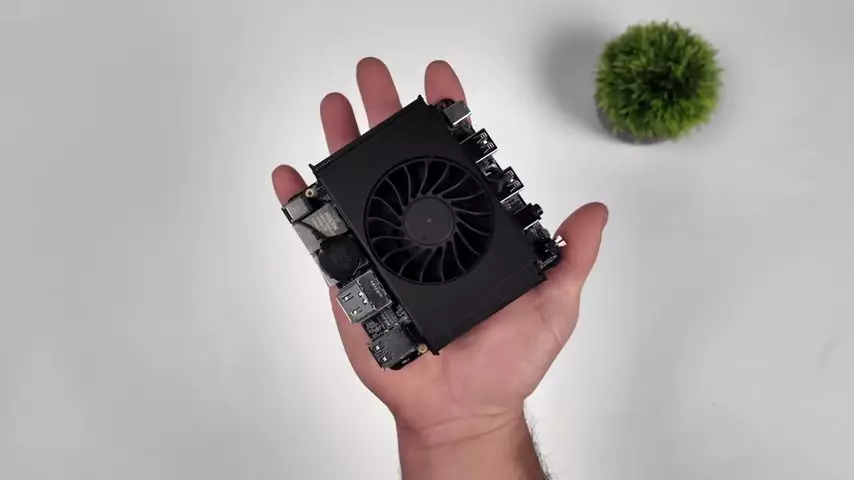The landscape of compact computing is continually evolving, with strides being made to deliver impressive gaming performance from increasingly smaller devices. One such development is the latest X86 Single Board Computer (SBC) featuring a Ryzen 7 7840HS and advanced graphics capabilities through its RDNA3 architecture. This new device prompts a reconsideration of the traditional notions surrounding gaming hardware, challenging the requirement for bulky dedicated graphical power in favor of more efficient, compact solutions.
At first glance, the sheer diminutive size of this X86 SBC is captivating. It is designed to fit snugly into the palm of your hand, reminiscent of mini-GPU form factors. Acknowledging the significance of size is essential; the compact form factor indicates a significant advancement in engineering and design, pushing the boundaries of how much power can be housed in such a limited space. The SBC is equipped with a Ryzen 7 7840HS SoC, paired with an integrated Radeon 780M graphics component, promising sufficient graphical prowess that challenges conventional gaming expectations.
Despite its small size, the device boasts specifications typically reserved for larger gaming laptops or powerful mini PCs. This raises intriguing possibilities for gamers seeking portable solutions without the frequent compromise in performance traditionally associated with miniaturization. Notably, users can enjoy a gaming experience that approaches desktop-level performance, dispelling any lingering doubts about the viability of mini computing for gaming.
When evaluating the performance specifications, it’s essential to consider the impact of the Ryzen RDNA3 architecture. This APU, with its integrated graphics capabilities, is engineered to handle modern gaming demands efficiently. During tests with popular titles like Doom Eternal and Overwatch 2, the device showcased commendable performance: achieving an average of 79 FPS on medium settings at 1080p and maintaining frame rates in the 80-100 FPS range in Overwatch 2. Such figures are noteworthy for an SBC of this size and indicate that it can indeed deliver a satisfying gaming experience.
However, it is essential to note the need for frame generation in resource-intensive titles such as God of War and Spiderman Remastered to achieve smooth performance. This dependence raises questions: while upscaling technologies can significantly enhance frame rates, one must wonder if the device can sustainably perform across a wider variety of demanding games in the long run. Despite this, the initial gaming performance reveals a noteworthy potential that aligns with modern gaming’s fluidity and visual appeal.
While this SBC impresses in numerous areas, it is not without its limitations. The soldered LPDDR5 RAM does restrict users regarding upgradeability, an aspect that might deter enthusiasts who favor customized systems. The choice of using older APU technology rather than the latest Strix Point variants could suggest an attempt to manage manufacturing costs, but it leaves one questioning whether this decision might hinder the SBC’s long-term viability.
Nevertheless, the onboard storage features prove to be a silver lining. With three M.2 slots available, this compact powerhouse outstrips many larger setups in terms of storage potential. This flexibility not only permits the addition of high-speed SSDs but also offers consumers a chance to tailor their storage solutions based on their specific needs.
The anticipated price of this SBC, around $329, is an attractive proposition considering its capabilities. For that cost, it’s conceivable to purchase a complete system that can hold its own against dedicated GPUs like the RTX 4060 Ti, which is priced higher when considered alone. Such pricing makes this device an intriguing option for budget-conscious gamers seeking versatility without sacrificing performance.
The expected launch through Indiegogo may also serve as a litmus test for market demand, enabling potential adjustments in production based on early feedback. Should it pass these initial hurdles, the SBC stands to carve a unique niche within affordable gaming systems.
In an era where powerful gaming hardware tends to be cumbersome, this new X86 SBC featuring the Ryzen RDNA3 APU offers a refreshing shift in perspective. Its combination of portability, performance, and price heralds a new era in gaming technology and suggests that compact devices are capable of delivering impressive gaming experiences. As technology continues to advance, it will be fascinating to see how this breakthrough product shapes expectations for future gaming rigs while pushing the limits of miniaturization further than ever before.

